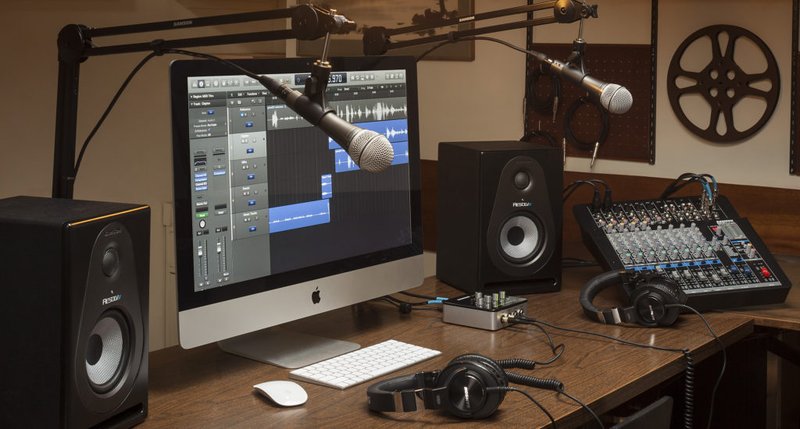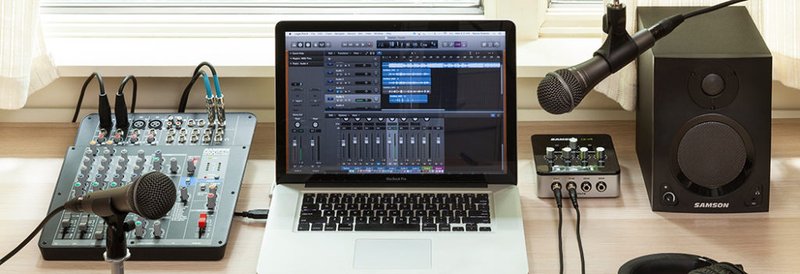Improving Your Digital Productions
The more effort and expertise you put into creating your podcast, as well as the higher the performance of the equipment you have to work with, the better the results you can achieve. Adding microphones will provide more separation between voices and audio sources. An external mixer will allow the levels of different microphones to be adjusted in real-time while recording is in progress. Using headphones will minimize feedback and echoes while providing better clarity. One of the most important tasks when getting started is to have a clean, quiet and organized place to work when recording your podcasts.
Minimizing Noise
Keep your recording area clean of anything that is not a part of your podcast. The ruffling of papers makes noise, and that noise will be picked up by your microphones. If you need notes, you may want try note cards, stacked in order and ready to use. Turn off any stray electronic sounds. Obviously, it’s best not to have a TV or radio blaring in the background, but also turn off any alert signals or chimes on your computer or smartphone. Also, turn off any noisy fans or air conditioners, and put the barking dog in another room.

Adding Microphones
Using additional microphones provides better separation between sound sources such as a host and guest. In addition, having separate microphones makes it possible to have independent control over the equalization. This way, you can perfectly shape the tone, and to apply any reverb or other effects individually to make each podcast personality sound their very best.
Using an Audio Mixer
Nearly all recording apps and software will have a built-in mixer of some sort. However, using an external USB mixer can still provide the best results. Samson’s MixPad® MXP124FX is an intuitive, easy-to-use mixer that is packed with professional features. Each of its four XLR inputs can accommodate most mics and offers three bands of EQ control; available phantom power makes it possible to use your favorite studio-grade condenser mics. Plus, there are four additional stereo inputs—perfect for mixing in pre-recorded comments or interviews, as well as cueing in theme and bed music to add a professional touch to your productions. A single USB cable provides a 2-way audio connection between the mixer and your laptop or computer.

Effective Monitoring
If you’ve expanded your podcast setup to include a few microphones and an external mixer, it may be time to look into an enhanced monitoring system. Samson’s Resolv Series of active (powered) monitor speakers come in a couple unique models, each with an array of sizes to fit any studio. Of course, an ideal way to monitor is with everyone using headphones, that way the microphones are not picking up any sound from the monitor speakers; isolation and control are improved. The Samson QH4 is compact headphone amplifier that offers four channels of individual level and tone control, and can drive up to four sets of headphones. Read more about monitoring issues.
Audio Editing
Editing your audio recording is part of creating a refined podcast. Programs and apps such as Audacity and GarageBand are available at no charge in most cases. Editing your audio recording can include simple tasks like removing coughs and sneezes (or inappropriate language); tightening up the empty spaces to remove excess silence; or working in additional audio such as a guest’s full title and credentials, sound effects—or even adding your podcast’s theme song to the intro and outro of the show.
Polishing Your Production
In addition to creating a great program with excellent levels, minimum noise, no feedback, well-edited dialog and an interesting topic, try to visualize your podcast as a serialized show with unique, individual episodes. Having a compelling title, choosing a standard length for your podcast episodes and introducing a recurring theme song will help to give your podcast a distinct identity. Even if the original recording is made on your iPad, for example, you can export that file and load it into your laptop or home computer to perform any needed edits with increased accuracy. Remember, your podcast is your creative contribution to the online world; take pride in your productions and give your podcast the professional edge it needs to get noticed.
